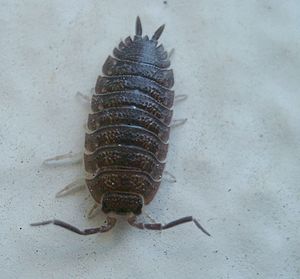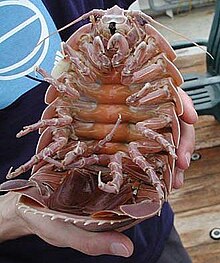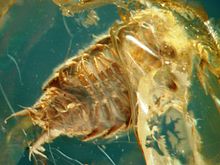Woodlice
| Woodlice | ||||||||||||
|---|---|---|---|---|---|---|---|---|---|---|---|---|

Wood louse ( Porcellio scaber ) |
||||||||||||
| Systematics | ||||||||||||
|
||||||||||||
| Scientific name | ||||||||||||
| Isopoda | ||||||||||||
| Latreille , 1817 |
The woodlice (Isopoda) are an order that belongs to the class of the higher crustaceans (Malacostraca). Woodlice are 0.3 mm to approximately 50 cm in size. Most woodlice are herbivores and are therefore one of the first biological decomposers.
In contrast to the closely related amphipods, the body of the woodlice is flattened from the back to the belly. You have seven pairs of legs and a constant number of limbs. The gills are on the back legs. However, different species show different levels of adaptation to life on land. In addition to gill breathing, there are also species with other respiratory organs such as trachea or lungs.
The original habitat of the woodlice is the sea . But they can also be found in fresh water. One group - the lobsters - has left the water, but has consistently maintained their gill breathing. The young develop directly from eggs in a brood pouch ( marsupium ) under the body of the female. A female can have up to 100 young animals per year. Since the woodlice have to keep their delicate gill appendages constantly moist, they prefer moist habitats , but can also be found in dry places. You can find the wood isopod ( Oniscus asellus ) in fallen leaves, under tree stumps and under stones. With their mouthparts ( mandibles ) they can eat fallen leaves and dead wood .
Systematics



The order includes approximately 10,000 known species in an estimated 120 families, which are divided into ten suborders.
- Anthuridea (marine worldwide, but also in brackish and fresh water)
- Asellota (mainly in the deep sea of the Pacific and Atlantic Ocean , but also in fresh water, e.g. the water louse )
- Calabozoidea (in freshwater and groundwater in South America)
- Epicaridea (ectoparasites on marine crustaceans worldwide)
- Flabellifera (worldwide marine and freshwater occurring polyphyletic group with some parasitic representatives; the giant isopods belong to the scavengers within this group )
- Gnathiidea (the larvae are fish parasites, the adult animals live freely in marine benthos of all deep zones)
- Microcerberidea (smaller than 2 mm, in the interstitial of fresh water and the seas, on the east Pacific coasts of South America, in Africa, India and in the Mediterranean)
- Landluse (Oniscidea) (worldwide, mainly in damp, but also occasionally in dry places on land)
- Phreatoicidea (in surface waters, swamps, springs and groundwater of the southern hemisphere even at high altitudes)
- Valvifera (marine, mainly Circumarctic and Antarctic, the Baltic sea louse is common in European seas )
Types (selection)
- Wood louse ( Porcellio scaber )
- Cliff isopod ( Ligia oceanica )
- Wall wood louse ( Oniscus asellus )
- Armadillidium opacum
- Common roll louse ( Armadillidium vulgare )
- Giant isopods (genus Bathynomus )
- Water louse ( Asellus aquaticus )
- Cymothoa exigua
Fossil evidence
Fossil evidence is known from almost all geological periods since the Zechstein , but overall it is rare. Due to the mostly very difficult fossilization conditions on land, most of them are aquatic forms. Exceptions are inclusions in amber , which by nature are predominantly terrestrial forms. The isopods of the Eocene / Oligocene Baltic amber represent the entire spectrum from water dwellers to moisture-loving forms and inhabitants of dry habitats .
Web links
- Isopods at "Brehm" on assel.net
- Classification at BioImages ( Memento from December 13, 2007 in the Internet Archive ) (as of December 13, 2007)
- The order "woodlice". In: Fauna Europaea Database. European Commission under the Fifth Framework Program, accessed on February 27, 2010 .
Individual evidence
- ↑ Boyko, CB; Bruce, NL; Merrin, KL; Ota, Y .; Poore, GCB; Taiti, S .; Schotte, M. & Wilson, GDF (Eds) (2008 onwards). World Marine, Freshwater and Terrestrial Isopod Crustaceans database. Accessed at http://www.marinespecies.org/isopoda on May 22, 2016
- ↑ Brian Kensley, Marilyn Schotte and Steve Schilling: World List of Marine, Freshwater and Terrestrial Isopod Crustaceans Smithsonian National Museum of Natural History (accessed August 26, 2010)
- ^ ITIS: Isopoda
- ^ Arno Hermann Müller: Textbook of Palaeozoology. Volume II, part 3, Jena 1978.
- ↑ C. Gröhn: Inclusions in Baltic amber. Kiel / Hamburg 2015. ISBN 978-3-529-05457-0 .
